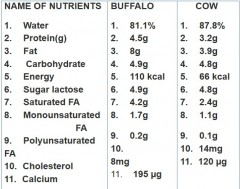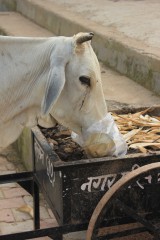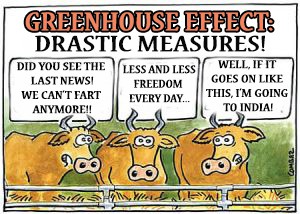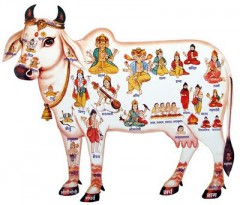03/28/2014
Fake cow milk!
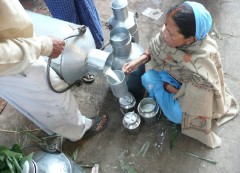 The discovery of the century! I’ve been drinking buffalo milk for years!
The discovery of the century! I’ve been drinking buffalo milk for years!
I didn’t believe it at first... But it is true: in India is not mandatory to mention the source of the milk on the packaging so when manufacturers do not indicate the source it means it is not cow milk. And I trusted Nestlé to give me “proper” milk like at home (I gave up milk in plastic bag the day when after learning that I had to boil it, I forget it on the stove and I burnt everything).
Cow milk and buffalo milk are not the same! Even if it is so much pasteurized that it tastes almost the same. First of all, since my cat discovered cow milk, he snubs buffalo milk, the best proof ever!
Secondly, buffalo milk has twice more fat than cow milk (hence it is less digestible). And it contains less cholesterol and more energy. I don’t know what is best for health – Indian websites praise buffalo milk (well of course, 50% of the world buffalo population live in India) – but whatever said and done, it's cheating to sell packaged milk without saying it's buffalo milk!
And I like milk. Even though nowadays we keep hearing that adults should not drink milk (because it is not so digestible). And in India when you see what garbage cows eat, you’d rather stop drinking milk at all (apparently some people cut buffalo milk with water to lower the fat content and claim it is cow milk – cow milk has good reputation because foreigners only drink this one).
Sources: http://profwaqarhussain.blogspot.in/2012/08/comparison-of-buffalo-milk-ND-cow-milk.html; http://www.nddb.org/English/statistics/pages/population-India-species.aspx; http://www.fiapo.org/downloads/dairyreport.PDF; http://www.aavinmilk.com/dairyprofile.html; http://www.fssai.gov.in/portals/0/PDF/food%20Safety%20and%20standards%20%28Packaging%20and%20Labelling%29%20regulation, %202011.pdf; http://www.caiindia.org/PDFs/MILKEnglish.PDF; http://Lite.ePaper.timesofindia.com/mobile.aspx?article=Yes & pageid = 2 & sectid = edid = & edlabel = TOICH & mydateHid = 13-10-2011 & pubname = Times + of + India +- + Chennai & edname = & articleid = Ar00200 & publabel = you
08:00 Posted in Incredible India!, My stories in India | Permalink | Comments (0) | Tags: india, milk, buffalo milk, cow milk, packaged milk, cow, packaging | ![]() Facebook | |
Facebook | |
10/06/2013
Why in India cows roam freely in the streets?
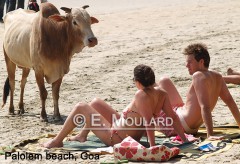 We just saw why cows are considered as sacred in India; and the advantage of being a God is that you can do what you want when you want where you want... So if a cow wants to be where it is, well it just stays here!
We just saw why cows are considered as sacred in India; and the advantage of being a God is that you can do what you want when you want where you want... So if a cow wants to be where it is, well it just stays here!
We have the right to blow their ears by honking like mad but not to touch them... Talking of ears, I have a feeling that bovines have not a very developed hearing... Coupled with an overdeveloped nonchalance and you have it… huge traffic jams!
But in the first place, why are they in the streets?
You can find the cows that belong to temples (they are sacred remember).
But most of them belong to ‘urban farmers’ who provide the daily fresh milk Indians are fond of (because of habit, taste and cost).
And why do their owners leave them in the streets? Because it reduces their food budget! On the one hand they eat garbage (organic waste and not so organic (a downward slide of modernization)) and on the other hand they get fed by people (accomplishing the good deed of feeding a God!).) They gather them for milking...
One might wonder why we see less she-buffaloes roaming around on their own (whereas they are also in the cities where you can see them walking in herds)? They would be dumber than cows and have more difficulties finding their shelter and master...
And then there are the old cows. Which are of no more use. And as it is forbidden to euthanize them, their owners prefer to abandon them in the streets. In addition to this legal explanation, there is also a religious dimension: “Higher castes consider the body of the dead cow polluting; if they do handle it, they must go through a rite of purification.”*
What happens to them then? The out-casts (lower than the low castes), the Untouchables, are called to the rescue to haul away the carcass from which they will take the meat and skin to make leather...
08:00 Posted in Why in India... | Permalink | Comments (0) | Tags: india, cow, meat, cows on the streets, temple cows, milk, euthanasia, killing a cow, old cows, untouchables, she-buffaloes, cows | ![]() Facebook | |
Facebook | |
10/04/2013
Why in India cows are sacred?
In my humble opinion, the cow is holy because, as everywhere (before industrialization), it is an animal that is super useful: it eats food waste, it provides cow-power to work in the fields, milk and dung (used as fertilizer, wall protection and combustible). And at the end of its life the cow also provides meat and leather. And two little add-ons in India: Panchagavya, a magical potion for plants and animals (including humans): it is prepared with five products from the cow (namely dung, urine, milk, curd, ghee (some fat product between oil and butter) with jaggery, banana, tender coconut and water. And Kambala, water buffalo races (see video).
Add all this to a (vague) tendency to venerate a more or less whatever comes their way and you get Indians worshipping cows! Simple...
Ah! Holy cow! Far from me the desire to stir up the debate as to whether it is good or bad to eat beef – I stopped preaching its nutritional qualities when I realized that if the billion of Indians was to eat it we may all end up suffocating in cow farts (sacred or not)!
Though it is worth highlighting that India holds the record for dairy cows (owning 15% of the 265 million animals populating the world (1)) and that, bad luck, dairy cows fart more than meaty cows (twice more exactly (2)). Pfffff as if Indians needed this additional pollution! Because, mind you, not only there are 38 million cows in India but also 100 million water buffaloes (3). And I don’t want to start thinking about buffalo farts!
Since we are at it, is a Buffalo holy or not? You need faith to worship such an ugly animal!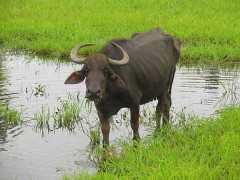 Joke apart, you get quite a shock when you are served a buffalo milk chai (yucky for me) or when you cook your first buffalo steak (thinking you bought beef) and it gives away yellow fat. So buffalo? Sacred or not sacred?
Joke apart, you get quite a shock when you are served a buffalo milk chai (yucky for me) or when you cook your first buffalo steak (thinking you bought beef) and it gives away yellow fat. So buffalo? Sacred or not sacred?
Well it depends on the States... Sometimes the bull, bullock and buffalo are considered as cows (in addition to the cow itself, the calf and the she-buffalo); sometimes not.
Sometimes, the "sacredness" of the cow can be waived: if it exceeds a certain age or if it is no longer viable (i.e. able to produce milk or calves or to pull a plough), even if in all cases it is necessary to ask for authorisation before euthanizing a cow; sometimes not.
Sometimes (especially in Kerala, West Bengal and North-eastern States) the cow is simply not "legally" sacred and there are 3,600 legal slaughter houses (and 32,000 illegal ones which provide 70% of the meat) (4); someone has to feed all the communities of beef-eaters (Christians, Muslims and indigenous tribes, for example). And even if they are minorities, on a basis of one billion people, as much buffalo is eaten in India as beef in France every year! It is a real business. There is even a big cow-trafficking from India to the neighbouring (beef-loving) countries (5).
The Indian Constitution does not ban cow-slaughtering but protect the animal: “The State shall endeavour to organise agriculture and animal husbandry on modern and scientific lines and shall, in particular, take steps for preserving and improving the breeds, and prohibiting the slaughter, of cows and calves and other milch and draught cattle.” (Article 48)
De facto, the States have their own Prevention of Cow Slaughters Acts and the right to ban or restrict it and penalize it (6) (the killing of a cow can be punished with imprisonment (up to 7 years) and/or a fine (up to 50,000 Rs)). With as many as 28 different states and rules that change at the discretion of the governments, difficult to know where you stand!
It is indeed a verrrry sensitive topic in India and politicians don’t hesitate to use it. For instance, a story of cartridges coated with cow and pig fat almost led the Britishers to lose their colony in 1857 (7)!
Another example is the anti-cow slaughtering riots that shook India in August 1893 and caused a hundred deaths: while two festivals (Hindu and Muslim) coincided in Bombay, the press reported the sacrifice of a cow by the Muslims and things got out of control (8).
Just to say that Hindu politicians do not hesitate to invoke the holiness of the cow to agitate crowds and win votes...
Every year a water buffalo (Kambala) takes place in Kasargod (Kerala)
Next we will see why cows are free to wander in the streets in India!
(1) “India became the first world nation in milk production in 2001, ahead of the USA. In 2010, Indians produced 108 million tonnes whereas they were at 19 million 40 years earlier. Launched by the Government in 1970, the country operated a 'white revolution '. The goal: to achieve self-sufficiency to feed the population and fight poverty by providing an additional income to farmers. The number of cows is huge but the structure remains very traditional, because of religion. The cow is considered a sacred animal.” In addition, “the global production is dominated by cow milk which represents 83% of the quantities produced in 2010. Far behind, bufallo milk weighs 13%. She-buffalo milk is not common in Europe and is mainly collected in Asian countries (India, Pakistan, China).” Sources: http://www.produits-laitiers.com/Economie-et-Societe/filiere/Monde/; http://www.lemangeur-OCHA.com/Ouvrage/cultures-des-laits-du-Monde/; http://www.FAO.org/AG/againfo/programmes/FR/PPLPI/docarc/pb_wp2.html; http://www.lebulletin.com/Autres/l%E2%80%99inde-Domine-avec-38-millions-de-Vaches-30113
(2) For reasons of growth and nutrition. Source: http://www.crioc.be/files/fr/4128fr.pdf
Cow farts: the advantage of cattle is that they can feed exclusively on grass through their four stomachs and their bacteria. The downside is that this digestive specificity produces large quantities of methane, a gas contributing to the greenhouse effect and global warming. Sources: http://www.crioc.be/files/fr/4128fr.pdf; http://www.challenges.fr/Industrie/20130828.CHA3458/Le-Poisson-d-Elevage-s-EST-fait-plus-Gros-que-le-b-UF.html
(3) Buffalo:http://www.buffalopedia.cirb.res.in/index.php?option=com_content&view=article&id=60&Itemid=65&lang=en; http://en.wikipedia.org/wiki/Water_buffalo
(4) Sources: http://www.academia.edu/929980/Negotiating_the_SacredCow_Cow_Slaughter_and_the_Regulation_of_Difference_in_India;
http://drfoxvet.com/library/info/india-sacred-suffering-holy-cow
(5) 1.15 tonnes of buffalo consumed in India every year and 1.55 tonnes of beef in France.Sources: http://blogs.independent.co.uk/2012/04/30/food-fascism-the-vegetarian-hypocrisy-in-india/; http://www.planetoscope.com/elevage-viande/1587-consommation-de-viande-de-boeuf-en-france.html
Source on cow trafficking: http://www.csmonitor.com/world/global-news/2013/0126/cow-smuggling-it-s-how-Bangladesh-gets-its-beef
(6) 'The Article 48 of the Indian Constitution directs the State to take necessary steps for prohibiting the slaughter of cows and calves” Source: http://blogs.independent.co.UK/2012/04/30/food-fascism-the-vegetarian-hypocrisy-in-India/
Other sources: http://www.academia.edu/929980/Negotiating_the_SacredCow_Cow_Slaughter_and_the_Regulation_of_Difference_in_India; http://articles.timesofindia.Indiatimes.com/2012-12-16/Bangalore/35850723_1_cow-slaughter-preservation-of-cattle-Bill-cattle-Prevention-Act
(7) The protection of the cow started to gain importance in 1857, four years after new cartridges were introduced with greased paper. To open the cartridge, the sepoys (Indian soldiers of the British Army) had to tear off the paper with the teeth. A rumour started that the fat used was a mixture of pork and beef fat. And boom, both Hindu and Muslim sepoys rebelled (it was the last straw) and it took a year to put down the rebellion. And yes, the Indian independence process did not happen only through nonviolence. Sources: http://asianhistory.about.com/od/india/f/What-Was-The-Revolt-Of-1857-in-India-All-About.html; http://www.sjsu.edu/people/shantanu.phukan/courses/114/s1/Metcalf-Early%2020th%20Century%20India%20&%20Colonial%20Resistance.pdf
(8) http://paperspast.natlib.govt.nz/cgi-bin/paperspast?a=d&d=THD18931006.2.34
08:00 Posted in Why in India... | Permalink | Comments (0) | Tags: panchagavya, cow, holy cow, hinduism, dung, urine, milk, ghee, buffalo, she-buffalo, calf, bullock, dairy cow, environment, fart, slaughter, beef, meat, vegetarian, non-vegetarien, constitution, law, water buffalo, kambala, kerala, buffalo racing, cow fart, gaz, cow-trafficking | ![]() Facebook | |
Facebook | |















